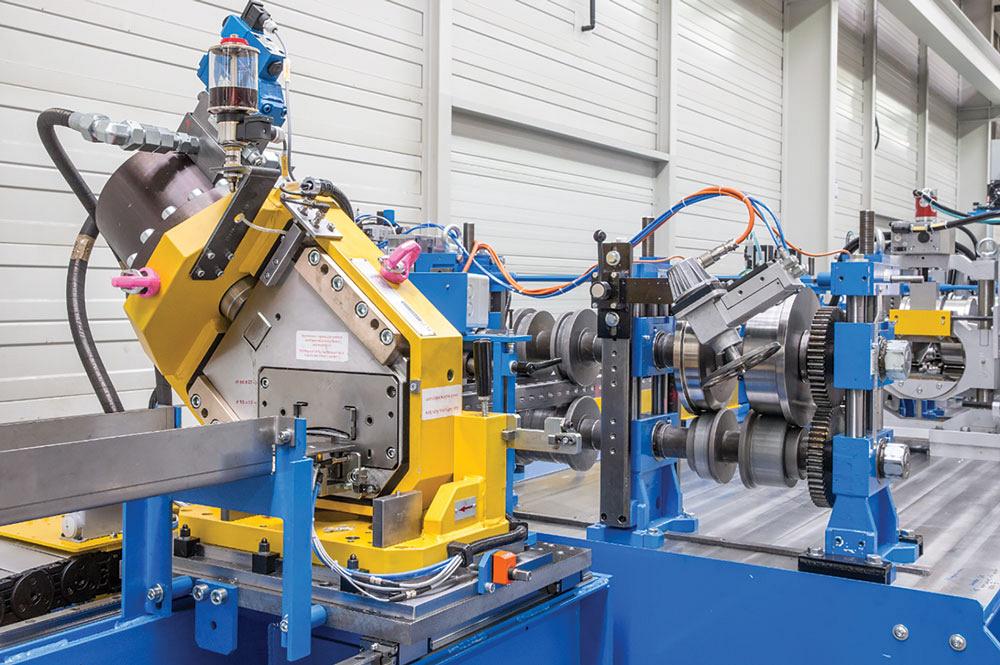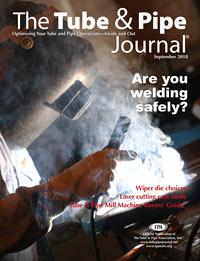- FMA
- The Fabricator
- FABTECH
- Canadian Metalworking
Categories
- Additive Manufacturing
- Aluminum Welding
- Arc Welding
- Assembly and Joining
- Automation and Robotics
- Bending and Forming
- Consumables
- Cutting and Weld Prep
- Electric Vehicles
- En Español
- Finishing
- Hydroforming
- Laser Cutting
- Laser Welding
- Machining
- Manufacturing Software
- Materials Handling
- Metals/Materials
- Oxyfuel Cutting
- Plasma Cutting
- Power Tools
- Punching and Other Holemaking
- Roll Forming
- Safety
- Sawing
- Shearing
- Shop Management
- Testing and Measuring
- Tube and Pipe Fabrication
- Tube and Pipe Production
- Waterjet Cutting
Industry Directory
Webcasts
Podcasts
FAB 40
Advertise
Subscribe
Account Login
Search
Racking system manufacturer cuts changeover times, waste on roll forming lines
- August 22, 2018
- Article
- Roll Forming
Situation
In 2007 racking systems manufacturer Micron, Velikiye Luki, Russia, undertook a project to convert all its production processes to systems based on the Toyota production system (TPS) to ensure that products would be manufactured on time and in line with demand while eliminating material waste, resource waste, and inventories. A decade later the firm wanted the various profiles for its racking systems to be made with the same just-in-time (JIT) approach. Specifically, the manufacturer wanted to be able to change cross-sections without any waste and with a setup time of less than 11 minutes.
The entire process of producing a section on one of the old systems, a component 98 feet long, generated more than 196 ft. of scrap, which meant the scrap produced with small batch sizes actually exceeded the total length of the parts being made.
The average setup time for a section change from one part to another on a roll forming line was 2.5 hours. With just three setup operations on a normal workday, there was hardly time left to produce anything. By reducing the setup time to 11 min., as many as 20 setup operations per day, or 100 per week, would be possible and cost-effective.
Resolution
Micron approached roll forming systems manufacturer Dreistern, Schopfheim, Germany, to develop a modern roll forming line. As a result, Dreistern commissioned four roll forming lines for a total of five sections with 33 variants.
With the help of two roller feeds, the press can perform prepunching and postpunching on the flat strip as it is being fed in or ejected. Once the required production length is reached, the strip is cut directly downstream of the uncoiler. This means the system can produce parts in the desired batch size and use the entire strip length to its end, with the exception of a small residual piece about 3 ft. long.
A removal unit at the end of the forming line helps ensure that the last part is removed safely. Meanwhile, the remaining residual piece can be pulled out of the machine easily and disposed of, and no additional tools are required to run the system until empty.
When a repeated section is produced in a new length, the cutoff machine automatically cuts the material for each desired variant with a shearing cut without wasting material. And since the cutting point is detected based on hole patterns, the exact position of the punch pattern relative to the cutting point is accurate.
An additional length-measuring system integrated into the cutoff machine continuously measures the total length that has already been produced and the lengths of the product. Once the preset total quantity is reached, the strip stops automatically.
At the end of the commissioning process, the company achieved not only an 11-min. setup time, but 9 min. in certain cases. Three operators perform setup simultaneously: the first one enters the new program on the roll forming system, adjusts the axes, and replaces the shear plates on the cutoff machine; the second one sets up the die on the press or completely changes it; and the third changes the strip on the dual uncoiler.
“When feeding in the strip, the operator can pretty much do things blind next to the machine,” said Jürgen Greiner, Dreistern project manager. “There’s nothing to press, and there aren’t any obstruction contours where things could get stuck.”
The system relies on motor-driven control axes and stored parameter sets to optimize each setup, storing up to 1,000 unique setups. Servomotors on the roll forming machine move the adjusting axes until they reach the correct position, helping to ensure accuracy and reproducibility. Likewise, the sheet thickness is adjusted automatically, and the three axes of the straightening unit also are motor-driven. Some of the axes, which can be adjusted manually, feature digital displays. If the set position deviates from the ideal location, a warning light signals this and displays the quantitative deviation.
Deviations can occur during straightening if the feedstock being used has tolerances that allow for this. Accordingly, the next time the program is used, the system will automatically move to the most recent values set for the corresponding coil, ensuring that manufacturing will use the optimum settings for the batch. This is especially important in JIT manufacturing when coils typically are not run until empty.
The press was designed for easy die replacement, so that it now is accessible from both sides. The outgoing die is pulled out from one side of the production line while the incoming die is slid into the workspace from the other side. If only an inlay needs to be replaced, this can be done from both sides.
Dreistern Inc., www.dreistern.com
About the Publication
subscribe now

The Tube and Pipe Journal became the first magazine dedicated to serving the metal tube and pipe industry in 1990. Today, it remains the only North American publication devoted to this industry, and it has become the most trusted source of information for tube and pipe professionals.
start your free subscription- Stay connected from anywhere

Easily access valuable industry resources now with full access to the digital edition of The Fabricator.

Easily access valuable industry resources now with full access to the digital edition of The Welder.

Easily access valuable industry resources now with full access to the digital edition of The Tube and Pipe Journal.
- Podcasting
- Podcast:
- The Fabricator Podcast
- Published:
- 04/16/2024
- Running Time:
- 63:29
In this episode of The Fabricator Podcast, Caleb Chamberlain, co-founder and CEO of OSH Cut, discusses his company’s...
- Trending Articles
Zekelman Industries to invest $120 million in Arkansas expansion

3D laser tube cutting system available in 3, 4, or 5 kW

Corrosion-inhibiting coating can be peeled off after use

Brushless copper tubing cutter adjusts to ODs up to 2-1/8 in.

HGG Profiling Equipment names area sales manager

- Industry Events
16th Annual Safety Conference
- April 30 - May 1, 2024
- Elgin,
Pipe and Tube Conference
- May 21 - 22, 2024
- Omaha, NE
World-Class Roll Forming Workshop
- June 5 - 6, 2024
- Louisville, KY
Advanced Laser Application Workshop
- June 25 - 27, 2024
- Novi, MI



























